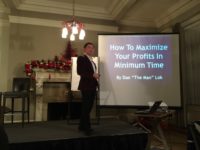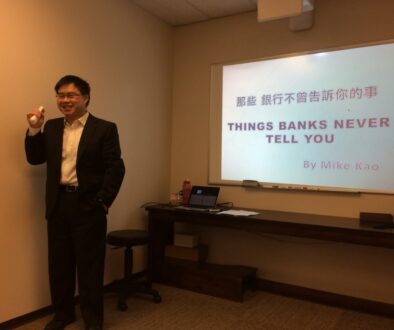How to maximize your profits in minimum time with Dan Lok
Date: December 9, 2015
Name: How to maximize your profits in minimum time with Dan Lok
Presenter: Dan Lok
Many entrepreneurs often forget to master the key of understanding financial statements. Moreover, entrepreneurs make mistake of leaving resources behind that could their business around. Vancouver Entrepreneurs Group invites Dan Lok, the serial entrepreneur, to discuss the important skill of reading and using financial statements. Since this is not an accounting course, Dan Lok will reveal simplest ways to use financial statements to make strategic business and investment decisions. This presentation will help entrepreneurs to clarify their business financial position and mitigate the fear of numbers.
Dan Lok is a multi-millionaire entrepreneur and an international author. His studies and strategies help many entrepreneurs to break their business barriers. Lok is also a keynote speakers for many businesses. Many entrepreneurs respect him as a business mentor. Moreover, he is the founder of the Vancouver Entrepreneurs Group, the owner of Charm Junction, and the author of FU Money.
Money and time are two major assets for entrepreneurs. Dan Lok believes these two assets can distinguish between successful and average entrepreneurs. Many entrepreneurs are losing money without even know why; in fact, Lok believes successful entrepreneurs will understand it, take it and use it. Lok mentions Keith Cunningham, the real rich dad in Rich Dad Poor Dad from Robert Kiyosaki. Cunningham created over 100 million dollars, but lost by the age of 40. He recovered back quickly. Lok takes the best lessons from Keith Cunningham and he would like to share the 8 profit maximizers that will help entrepreneurs to explode their businesses.
Maximizer #1: Strategic thinking versus tactical thinking
Lok states many entrepreneurs are strategic thinking. There is a difference between strategy and tactics. Strategy is done above the shoulders and tactics are done below the shoulders. A strategy is a plan that overcomes the obstacles and the only job as an entrepreneurs is to understand the obstacles. Lok shares a philosophy from Sun Tzu, the creator of The Art of War, is that strategy without tactics is the slowest route to victory and tactics without strategy is the noise before defeat.
Lok provides a list that shows the difference between strategic thinking and tactical thinking.
| Strategic | Tactical |
| Direction | Implementation |
| Strategy Statement | Annual Plans |
| Broad | Specific Detailed |
| Unstructured | Structured |
| Creativity | Analytical |
| External Focus | Internal Focus |
| Irregular | Regular |
| Long Term | Short Term |
| Difficult to Evaluate | Easy to Evaluate |
| Senior Management | Middle-level Management |
“How much time you spend on each?”
Many entrepreneurs will delegate or outsource the tactics. However, Lok suggests entrepreneurs must know within first. The more they know, the more understand of the result they want to achieve because in business world, there is nobody cares more than themselves.
“What you think might not what you need”
Maximizer #2: Financial literacy is the key to life long financial success
Many entrepreneurs do not look at financial. Lok emphasizes in entrepreneurship, it is not how much entrepreneurs make, and it is how much they keep. Accounting is the language of business and if entrepreneurs do not speak the language, it will be difficult to win the game of business.
Financial statements can help entrepreneurs to guide back their direction when their business is off course. Entrepreneurs cannot improve their business when they cannot measure. Therefore, Lok believes the goal of business is not to get rich, but to stay rich.
“Sustainability always comes from knowing what you are doing and measuring your progress”
Lok has a philosophy. Instead of knowing how much he can make, he needs to know how much he can afford to lose. In any business cycle, entrepreneurs will make money and lose money. It is important to make money and minimize the lost. Usually, many entrepreneurs will feel invincible when they are making money. They tend to gamble and lost more at the end. Lok wants entrepreneurs to look at downsize risk. The problem entrepreneurs are having today is not that they do not have enough opportunities to make money; instead, the problem is that they have too many opportunities to lose it.
“Are you taking too much risk?”
When entrepreneurs do not understand the scoreboard, it is hard to tell who is winning. Accounting is not the scoreboard; in fact, it is the report card. Many banks will loan money to entrepreneurs when they do not need money. Therefore, Lok will explain and simplify how to read financial statements.
Balance Sheet is like the snapshot of the business. The asset section is all the resources that company has. Liability section is the stuff company owes and the equity section is the stuff company owns. Balance sheet shows the snapshot in time and it also shows what company owns and owes.
Income statement is the theory of the business. The difference between sales and cost of good sold is the gross profit. By deducing the expenses from gross profit, it shows the net income, which is the profit. Entrepreneurs must understand that they cannot deposit profit. Income statement can be very helpful, but it can also be very dangerous. The number at the bottom can be misleading. Company can have high profitability with no cash or high deficit with significant amount of cash. By just looking at the profit, it is hard to determine if business is doing well or not. Therefore, entrepreneurs should not make business decision on net income or profit.
Entrepreneurs must know the story behind the number. Lok believes it is a poor way to run business or determine the financial health of business by running the business out of a check book, tax return or looking at the net income.
Cash flow is the fact of the business. Cash is real money and it is the only thing that hits the bank account. However, not all cash is created equally. There are 3 types of cash.
- Operating cash flow (OCF)
- Investing cash flow (ICF)
- Financing cash flow (FCF)
OCF is to generate or used by operation. ICF is to generate or used in buying or selling fix assets. Finally, the FCF is to generate or used from lenders or investors.
To calculate FCF, entrepreneurs can take ICF and minus the OCF. In addition, when entrepreneurs want to calculate free cash flow, they can take the OCF and minus ICF.
There are 3 ways of OCF tests entrepreneurs can use to determine the health of their businesses. The first way is to see if the OCF is positive. If OCF is negative, there is a problem. The second way is to see if OCF is greater than profits. If not, there is a problem in accounts receivable, inventory or accounts payable. The third way is to see if OCF is growing faster than profits. If not, it means the business is becoming less and less productive.
Lok wants entrepreneurs to remember that rich people get paid before they do the work, and poor people get paid after they do the work. Lok shares a strategy to change clients to pay up front is to say “The way all my clients always pay me up front”.
“You can operate a long time without a profit, but you cannot survive a week without cash”
“Ignorance is not a bliss; fact do not cease to exist just because you ignore them”
Lok believes the number one key to long term business success is to avoid bad assumptions. Entrepreneurs need to verify the assumptions. Lok provides a scenario that helps entrepreneurs to read financial statement.
Tips to read financial statements
- Figure out the trend from past history years
- Determine the increase or decrease from different accounts in financial statements
- Exam the accounts receivable for cash that are collected
- Review the liability for irregular expense not paid or outstanding loans
- Pay attention to the level of inventory
- Look at the change from expenses to see where cash spend
- Watch the gross profit percentage to understand the changes of revenue and cost of good sold
- Review cash flow statement to track where cash went
“How much more money would you still have if you did not make those bad investment or bad business decisions?”
Maximizer #3: Think time
Lok believes business is an intellectual sport. Many entrepreneurs have the misconception of thinking they can do what they love and money will follow. Entrepreneurs cannot just believe in something and it will make it true.
There are 3 most powerful question entrepreneurs can ask themselves.
- What could go wrong?
- What don’t I know?
- What don’t I see?
Smart entrepreneurs have good answers and genius entrepreneurs have good questions. Lok suggests entrepreneurs to schedule their think time once per day. The process of think time is to write down a question and think as much answers as possible. When they are stuck, they can ask themselves what assumptions they are making that they are not aware or they are making what gives them what they see.
Maximizer #4: You must get owner compensation right to know what your true pretax profit is
Most entrepreneurs misunderstand the relationship between their salary and the return on what they own. In fact, many entrepreneurs should get paid a salary for what they do and they should get a return on what they own. Therefore, entrepreneurs must pay themselves at a market wage. Many entrepreneurs think they are overpaying themselves, but in reality, over 90% of them are underpaying.
Lok wants entrepreneurs to imagine if they got run by a bus today and their families decide to keep the business going in their absence, how much do they need to pay.
Lok indicates business is like a cow. Until they paid themselves a market-based wage and make a profit on top of that, they have a sick ow on their hands. Therefore, entrepreneurs should not focus on paying taxes; instead, they should focus on increasing their profits.
Maximizer #5: Master the wealth cycle
The purpose of business is to provide future profit streams. The wealth cycle is made up of 4 parts.
- Assets
- Sales
- Profits
- Cashflow
The primary reason to have assets in business is to produce and serve revenue. Entrepreneurs need to be effective at acquiring assets that maximize and serve revenue. They need to be efficient at converting those revenue into profit. They need to be productive at converting profits into cash. As an entrepreneur, it is important to have as few assets as possible to produce the maximum amount of revenue.
Maximizer #6: bigger is not always better
Entrepreneurs must understand that the goal is not to get big, yet the goal is to create sustainable success. For example, entrepreneurs would rather own a 2 million a year business that is making 15% than a 5 million a year business that is making only 5%.
Maximizer #7: No overhead growth
When entrepreneurs think about every dollar they spend as money they are investing in their business, all their investments will produce a return. Lok suggests all entrepreneurs to read “Berkshire Hathaway” to understand his way of operating business with few investments.
The reason most entrepreneurs want better office, car or computer equipments for business is because they let their emotions and ego dictate their expenditures. Entrepreneurs should ask themselves if the investment in expenditures will generate additional revenue. Better expenditures and high overhead do not define success. Spending money to look like a big deal is not the same as being a big deal. Therefore, how entrepreneurs run their business during the good time is a great indicator of how well they will survive the bad times. Lok recommends entrepreneurs to generate money as much as possible in the bank when the business is good.
Lok believes the fastest path to profit maximization is to reduce the drag of expenses and not building a bigger sales engine or pushing the growth expenses. The focus should be how to grow top line revenue and maintain or reduce expenses.
“Always pick the low-hanging fruit”
Maximizer 8: Meet with an accounting professional and review your financial every month
The business process consists of 4 steps.
- Management
- Decisions
- Activities
- Results
Entrepreneurs can utilize their accountants to monitor, review and measure the step from activities to results. Furthermore, it is entrepreneur’s job to take the result and put it back to activities.
“Manage result, change activities”





